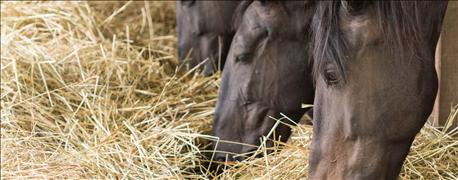November 4, 2016

Forage makes up between 50% and 90% or more of a horse’s diet. Much of the forage part of the diet comes in the form of hay. Because it’s such a big part of the ration, good quality hay can help keep a horse healthy, while poor quality hay can be detrimental.
“As nutritionists and horse owners, we put a big emphasis on the quality of hay we feed,” says Gina M. Fresquez, technical specialist for Equine Technical Services at Purina Animal Nutrition.
 Six tips for selecting good quality horse hay, which makes up 50% to 90% of a horse's diet. (Photo: jax973/Thinkstock)
Six tips for selecting good quality horse hay, which makes up 50% to 90% of a horse's diet. (Photo: jax973/Thinkstock)
“The most important factor determining hay quality is the stage of plant maturity at time of harvest,” says Fresquez. “Young, immature plants contain more nutrients than older, stemmier plants. Though after hay is harvested, the level of hay quality goes beyond the age of the plant at harvest as there are more factors to consider.”
When selecting your horse’s forage, Fresquez recommends keeping these six signs of good quality hay in mind.
1. High leaf-to-stem ratio
Think about the leafy greens you eat. You likely prefer greens with leaves rather than just stems. The same is true for your horse.
“Look for more flat leaves in the hay and fewer round stems; this indicates the plant was less mature when cut,” says Fresquez. “More leaves typically mean higher digestibility and nutrient content for your horse.”
2. Small diameter stems
Stems smaller in diameter or finer are also indicators of higher quality. Small stems mean the plant was less mature when cut.
To test stem size, Fresquez recommends grabbing a handful of hay and giving it a squeeze.
“Good quality hay is soft and pliable, and feels good in your hand,” says Fresquez. “If it feels like you’re squeezing a handful of sticks, it is not a good choice of hay to feed your horse.”
3. Few seed heads or blooms
No matter the species of plant, hay with little to no seed heads or blooms indicates a younger, early maturity plant, and thus a higher quality hay. For example, timothy should be cut in the pre-bloom or early-bloom stage when you see little to no seed heads; and alfalfa (for horses) should be cut at early to mid-bloom stage.
4. Fresh smell and appearance
Avoid musty, moldy or off-setting smelling hay, because it can reduce palatability and indicate poor quality.
“On our farm, there’s nothing like haying season,” comments Fresquez. “We love the smell of fresh hay. The same is true for your horse. Good quality hay should have a fresh cut smell and appearance.”
5. Cleanliness
Hay should be primarily made up of the harvested forages. Fresquez recommends looking for a clean forage with little to no dust. Even if most of the hay is high quality, hays containing dirt, mold, weeds, trash or other foreign materials indicate poorer quality hay and may be unfit to feed to horses.
6. Color
Good quality hay should be bright green in color with little fading. A bleached, yellow, brown or black color may indicate aged hay, mold or poor storage conditions.
“Storage conditions and age have a significant effect on vitamin content of hays,” says Fresquez. “Many vitamins, such as vitamins A and E, are not stable over time and lose biological activity. After approximately six months, almost all vitamin A and E activity levels are lost.” Exposure to heat, sunlight and rain will speed up this process.

Source: Purina Animal Nutrition LLC
You May Also Like




